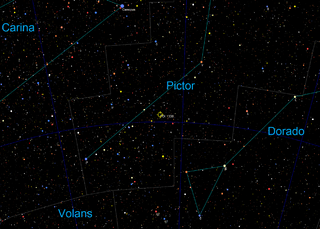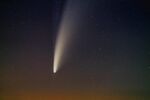Astronomy:TOI-1338
| Observation data Equinox J2000.0]] (ICRS) | |
|---|---|
| Constellation | Pictor |
| Right ascension | 06h 08m 31.968s[1] |
| Declination | −59° 32′ 28.08″[1] |
| Apparent magnitude (V) | 11.72[2] |
| Characteristics | |
| Spectral type | F8 / M[3] |
| Variable type | eclipsing[3] |
| Astrometry | |
| Radial velocity (Rv) | 23.56±5.34[1] km/s |
| Proper motion (μ) | RA: −12.057[1] mas/yr Dec.: +34.513[1] mas/yr |
| Parallax (π) | 2.4752 ± 0.0099[1] mas |
| Distance | 1,318 ± 5 ly (404 ± 2 pc) |
| Orbit[2] | |
| Period (P) | 14.608559+0.00013 −0.00012 d |
| Semi-major axis (a) | 0.1321+0.0024 −0.0025 astronomical unit|AU |
| Eccentricity (e) | 0.15603±0.00015 |
| Inclination (i) | 89.696+0.178 −0.114° |
| Semi-amplitude (K1) (primary) | 21.619±0.007 km/s |
| Details[2] | |
| TOI-1338 A | |
| Mass | 1.127+0.068 −0.069 M☉ |
| Radius | 1.331+0.024 −0.026 R☉ |
| Luminosity | 2.1[1] L☉ |
| Surface gravity (log g) | 4.0 cgs |
| Temperature | 6,160 K |
| Metallicity [Fe/H] | +0.01 dex |
| Rotation | 19±3 d |
| Rotational velocity (v sin i) | 3.6 km/s |
| Age | 4.4 Gyr |
| TOI-1338 B | |
| Mass | 0.3128+0.0113 −0.0118 M☉ |
| Radius | 0.3089+0.0056 −0.0060 R☉ |
| Other designations | |
TYC 8533-950-1, EBLM J0608-59, 2MASS J06083197-5932280, RAVE J060832.0-593228 | |
| Database references | |
| SIMBAD | data |
| Extrasolar Planets Encyclopaedia | data |
TOI-1338 is a binary star system located in the constellation Pictor, about 1,320 light-years from Earth.[2] It is orbited by two known circumbinary planets, TOI-1338 b, discovered by the Transiting Exoplanet Survey Satellite (TESS)[4] and BEBOP-1c, discovered by the Binaries Escorted By Orbiting Planets project.[5]
Discovery and nomenclature
The circumbinary planet TOI-1338 b was found in the summer of 2019 by Wolf Cukier, a 17-year-old attending Scarsdale High School in New York at the time, who joined the Goddard Space Flight Center as a summer intern.[6] The acronym TOI stands for "TESS Objects of Interest." Cukier studied data provided by volunteers of the Planet Hunters citizen science project, looking through data that had been flagged as an eclipsing binary.[7] Cukier and six of the Planet Hunter volunteers are co-authors of the publication regarding the planet.[2] Cukier currently attends Princeton University as an undergraduate student in the Department of Astrophysical Sciences and is expected to graduate in 2024.[8]
The discovery of TOI-1338 b was announced in early January 2020 at the 235th American Astronomical Society meeting in Honolulu, Hawaii.[9] In February 2021, a petition was launched calling for TOI-1338 b to be renamed SOPHIE in honor of late Scottish musician Sophie.[10][11] The petition was supported by Charli XCX and Caroline Polachek.[10] The petition was unsuccessful in renaming TOI-1338 b, however, the International Astronomical Union announced that the minor planet 1980 RE1 was given the permanent name Sophiexeon in June 2021.[12]
In 2023, a second circumbinary planet within the system was discovered, named BEBOP-1c. It was the first circumbinary planet to be found using the radial velocity method.[5]
The stellar binary

TOI-1338 is a single-lined spectroscopic binary system, consisting of an F8 star and a red dwarf of spectral type M. The system has an age of 4.4 billion years. The two stars with masses of 1.13 and 0.313 M☉ revolve around each other every 14.6 days. The red dwarf is about nine magnitudes fainter than the primary star and cannot be detected in the spectrum.[14][2]
The orbit of the two stars is inclined at 89.7° and both primary and secondary eclipses can be observed, although the brightness changes are very small. The primary eclipse occurs when the hotter primary star is partially occulted by the cooler secondary. It lasts about five hours and the brightness decreases by about 4%. The secondary eclipses occur when the cooler star is occulted by the hotter star. They also last about five hours but the brightness drops by less than half a percent.[2]
Planetary system
The planet TOI-1338 b is between Neptune and Saturn in size, and has an orbit that is within ~1° coplanar with the binary.[2] It is roughly 22 times the mass of Earth.[15] The spin of the primary star also aligns with the orbits of the binary and the planet (spin-orbit angle β = 2.8±17.1 °). This is the second time the Rossiter–McLaughlin effect was measured for a star hosting a circumbinary planet. Kepler-16 was the first system with such a measurement. The measurement of the alignment for TOI-1338 suggests that the planet formed from a single circumbinary disk.[16]
BEBOP-1c is a gas giant about 65 times the mass of Earth.[15]
| Companion (in order from star) |
Mass | Semimajor axis (AU) |
Orbital period (days) |
Eccentricity | Inclination | Radius |
|---|---|---|---|---|---|---|
| b | 33.0±20.0 M⊕ | 0.4607+0.0084 −0.0088 |
95.174+0.031 −0.035 |
0.0880+0.0043 −0.0033 |
89.37+0.35 −0.26° |
6.85±0.19 R⊕ |
| c | 65.2±11.8 M⊕ | 0.794±0.016 | 215.5±3.3 | <0.16 | — | — |
See also
- TOI-700
- TOI-849 b
References
- ↑ 1.0 1.1 1.2 1.3 1.4 1.5 1.6 Vallenari, A. et al. (2022). "Gaia Data Release 3. Summary of the content and survey properties". Astronomy & Astrophysics. doi:10.1051/0004-6361/202243940 Gaia DR3 record for this source at VizieR.
- ↑ 2.0 2.1 2.2 2.3 2.4 2.5 2.6 2.7 2.8 Kostov, Veselin B.; Orosz, Jerome A.; Feinstein, Adina D.; Welsh, William F.; Cukier, Wolf; Haghighipour, Nader; Quarles, Billy; Martin, David V. et al. (2020-05-07). "TOI-1338: TESS' First Transiting Circumbinary Planet". The Astronomical Journal 159 (6): 253. doi:10.3847/1538-3881/ab8a48. ISSN 1538-3881. Bibcode: 2020AJ....159..253K.
- ↑ 3.0 3.1 Triaud, Amaury H. M. J.; Martin, David V.; Ségransan, Damien; Smalley, Barry; Maxted, Pierre F. L.; Anderson, David R.; Bouchy, François; Collier Cameron, Andrew et al. (2017). "The EBLM Project. IV. Spectroscopic orbits of over 100 eclipsing M dwarfs masquerading as transiting hot Jupiters". Astronomy and Astrophysics 608: A129. doi:10.1051/0004-6361/201730993. Bibcode: 2017A&A...608A.129T.
- ↑ "ExoFOP TIC 260128333". https://exofop.ipac.caltech.edu/tess/target.php?id=260128333.
- ↑ 5.0 5.1 5.2 Standing, Matthew R.; Sairam, Lalitha; Martin, David V.; Triaud, Amaury H. M. J.; Correia, Alexandre C. M.; Coleman, Gavin A. L.; Baycroft, Thomas A.; Kunovac, Vedad et al. (2023), "Radial-velocity discovery of a second planet in the TOI-1338/BEBOP-1 circumbinary system", Nature Astronomy 7 (6): 702–714, doi:10.1038/s41550-023-01948-4, Bibcode: 2023NatAs...7..702S
- ↑ Pereira, Ivan (January 9, 2020). "New York teen discovers new planet while interning with NASA". ABC News. https://abcnews.go.com/US/york-teen-discovers-planet-interning-nasa/story?id=68169897.
- ↑ "Discovery Alert! High School Student Finds a World With Two Suns". https://exoplanets.nasa.gov/news/1619/discovery-alert-high-school-student-finds-a-world-with-two-suns/.
- ↑ Cukier, Wolf. "Wolf Cukier - Department of Astrophysical Sciences". © 2022 The Trustees of Princeton University. https://web.astro.princeton.edu/people/wolf-cukier.
- ↑ Hess, Abigail Johnson (2020-01-10). "17-year-old discovers planet 6.9 times larger than Earth on third day of internship with NASA" (in en). https://www.cnbc.com/2020/01/10/17-year-old-discovers-planet-on-third-day-of-internship-with-nasa.html.
- ↑ 10.0 10.1 "SOPHIE fans call for NASA to name a planet after the late musician". 3 February 2021. https://www.dazeddigital.com/music/article/51836/1/sophie-fans-call-for-nasa-to-name-planet-after-the-late-musician-charli-xcx.
- ↑ Richards, Will (30 January 2021). "DJ and producer SOPHIE has died". NME. https://www.nme.com/news/music/dj-and-producer-sophie-has-died-2868461.
- ↑ "WGSBN Bulletin, Volume 1, #3". International Astronomical Union. 2021-06-16. https://www.wgsbn-iau.org/files/Bulletins/V001/WGSBNBull_V001_003.pdf#page=7.
- ↑ "MAST: Barbara A. Mikulski Archive for Space Telescopes". Space Telescope Science Institute. https://mast.stsci.edu/portal/Mashup/Clients/Mast/Portal.html.
- ↑ Martin, David V.; Triaud, Amaury H. M. J.; Udry, Stephane; Marmier, Maxime; Maxted, Pierre F. L.; Cameron, Andrew Collier; Hellier, Coel; Pepe, Francesco et al. (April 2019). "The BEBOP radial-velocity survey for circumbinary planets I. Eight years of CORALIE observations of 47 single-line eclipsing binaries and abundance constraints on the masses of circumbinary planets". Astronomy & Astrophysics 624: A68. doi:10.1051/0004-6361/201833669. ISSN 0004-6361. Bibcode: 2019A&A...624A..68M.
- ↑ 15.0 15.1 Choi, Charles Q. (2023-06-12). "New Tatooine-like exoplanet discovered orbiting twin suns. Meet BEBOP-1c." (in en). https://www.space.com/tatooine-exoplanet-binary-systeim-twin-suns.
- ↑ Kunovac Hodzic, Vedad; Triaud, Amaury H. M. J.; Martin, David V.; Fabrycky, Daniel C.; Cegla, Heather M.; Collier Cameron, Andrew; Gill, Samuel; Hellier, Coel et al. (2020-07-01). "The EBLM project - VII. Spin-orbit alignment for the circumbinary planet host EBLM J0608-59 A/TOI-1338 A". Monthly Notices of the Royal Astronomical Society 497 (2): 1627–1633. doi:10.1093/mnras/staa2071. Bibcode: 2020MNRAS.497.1627K. http://adsabs.harvard.edu/abs/2020MNRAS.497.1627K.
External links
- TESS – Official WebSite
- NASA Telescope Discovers Its First Planet Orbiting Two Stars
- TOI 1338 at ExoFOP TESS
- The TOI 1338 subject at Planet Hunters, as mentioned in the paper
 |







